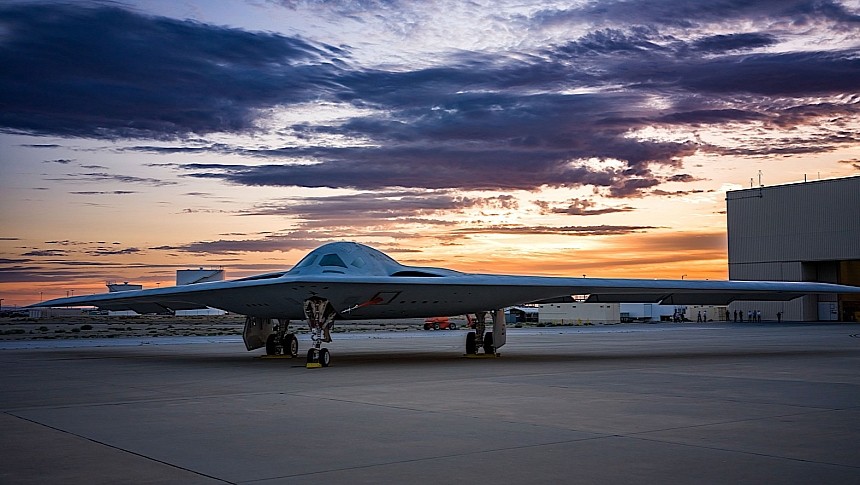It doesn't happen every day for the planet's most advanced nation to release a new military aircraft, so when it does the eyes of the world turn in America's direction. And that's exactly what happened at the end of last year, when the U.S. showed, for the first time, glimpses of something called the B-21 Raider.
Designed to be "the backbone of America's bomber fleet" in the not-so-distant future, the B-21 borrows some of its looks from the B-2 Spirit, but it couldn't be more different.
Smaller than the existing bomber, and thus capable of carrying about half the payload (about 30,000 pounds/13,600 kg), the Raider will however make up in stealth technologies and other hush-hush military gear.
Since this is a project still under development, the exact specs and characteristics of the bomber are not officially confirmed. The bird will have anywhere between two and four engines, and they will likely be of the Pratt & Whitney F135 (or something very similar to them) variety.
It is these exact mysterious engines that are the focus of the U.S. Air Force's attention these days, as the plane's maker, Northrop Grumman, announced the B-21 has begun engine runs in Palmdale, California.
What that means is that the flying weapon is now officially out and about on the tarmac of the company's facility there, and we finally get to see a shot of the plane as it sits there, under a beautiful sunset.
The photo, just like all the others of the Raider ever released, is not that revealing, showing us just a glimpse of the plane's front end, its landing gear, the cockpit, and the air intakes on the wings, serving what appears to be, after all, a two-engine configuration.
We're not told how long the engine run tests will last, but the company making the plane does say "engine testing is an essential milestone for the program." Naturally, without a successful completion of these runs a flight test will not be possible.
As to when that's expected to happen, Northrop Grumman is very tight-lipped. It does say the flight will be a "data-driven event," and that’s only natural for the early stage of development for any flying machine, let alone a nuclear bomber.
Some are still hopeful the new weapons platform will take to the sky by the end of the year, especially given how the military plans to have it up and about by the end of the decade. As per available information, around 100 of them are expected to join the existing bomber triad (comprising the B-1B Lancer, B-2 Spirit, and B-52 Stratofortress).
The estimated cost of the plane is around $553 million, higher than the $440 million spent for the purchase of the B-2. The total cost, including development and production, will of course be much higher.
Smaller than the existing bomber, and thus capable of carrying about half the payload (about 30,000 pounds/13,600 kg), the Raider will however make up in stealth technologies and other hush-hush military gear.
Since this is a project still under development, the exact specs and characteristics of the bomber are not officially confirmed. The bird will have anywhere between two and four engines, and they will likely be of the Pratt & Whitney F135 (or something very similar to them) variety.
It is these exact mysterious engines that are the focus of the U.S. Air Force's attention these days, as the plane's maker, Northrop Grumman, announced the B-21 has begun engine runs in Palmdale, California.
What that means is that the flying weapon is now officially out and about on the tarmac of the company's facility there, and we finally get to see a shot of the plane as it sits there, under a beautiful sunset.
The photo, just like all the others of the Raider ever released, is not that revealing, showing us just a glimpse of the plane's front end, its landing gear, the cockpit, and the air intakes on the wings, serving what appears to be, after all, a two-engine configuration.
We're not told how long the engine run tests will last, but the company making the plane does say "engine testing is an essential milestone for the program." Naturally, without a successful completion of these runs a flight test will not be possible.
As to when that's expected to happen, Northrop Grumman is very tight-lipped. It does say the flight will be a "data-driven event," and that’s only natural for the early stage of development for any flying machine, let alone a nuclear bomber.
Some are still hopeful the new weapons platform will take to the sky by the end of the year, especially given how the military plans to have it up and about by the end of the decade. As per available information, around 100 of them are expected to join the existing bomber triad (comprising the B-1B Lancer, B-2 Spirit, and B-52 Stratofortress).
The estimated cost of the plane is around $553 million, higher than the $440 million spent for the purchase of the B-2. The total cost, including development and production, will of course be much higher.









